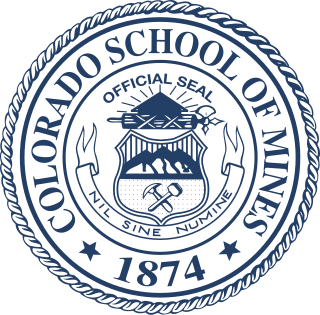
Colorado School of Mines (Mines) is a public research university in Golden, Colorado founded in 1874. The school offers both undergraduate and graduate degrees in engineering, science, and mathematics, with a focus on energy and the environment. While Mines does offer undergraduate minor programs in the humanities, arts, and social sciences, it only offers degree programs in STEM fields, with the exception of economics. In the Fall 2023 semester, the school had 7,101 students enrolled, including 5,443 undergraduate and 1,658 graduate students. The school has been coeducational since its founding but enrollment remains predominantly male. It is classified among "R1: Doctoral Universities – Very high research activity".
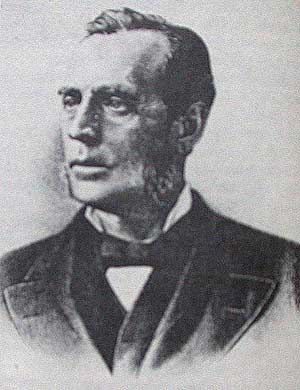
William Austin Hamilton Loveland was a U.S. railroad entrepreneur and businessman in the late 19th century. An early resident of Golden when it was the capital of the Colorado Territory, he was one of the founders of the Colorado Central Railroad and a principal figure in the early history of Colorado. As president of the Colorado Central, he was instrumental in the expansion of the railroad network into the mining communities of Colorado. For much of the 1870s Loveland waged a fierce struggle with Union Pacific investors for control of the Colorado Central. He also served as Lieutenant Governor of Colorado.
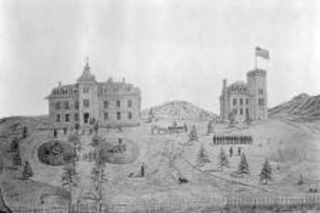
The Colorado University Schools campus was the multi-collegiate campus in Golden, Colorado, spearheaded by the visionary missionary Bishop George Maxwell Randall of the Episcopal Church.

Jarvis Hall was a Colorado liberal arts, grammar and military college from 1870–1904. Initiated in 1868 by Bishop George Maxwell Randall of the Protestant Episcopal Church and named after benefactor George A. Jarvis. The 1878-1882 building in Golden, Colorado remains as a private residence, and the 1882-1904 site near Denver is part of the Lowry Campus.

Daniel Sylvester Tuttle was consecrated a bishop of the Episcopal Church in 1866. His first assignment was as Bishop of Montana, a missionary field that included Montana, Utah, and Idaho.

The University of Wyoming College of Law is the law school of the University of Wyoming and the only law school located in Wyoming. It is situated in the Rocky Mountains in Laramie, Wyoming at 7,165 ft. between the Laramie Mountains and Snowy Range Mountains. Frequently, it is referred to as "Law at its Highest Point". Established in 1920, the law school offers the J.D. degree in law, as well "a joint JD/MA in Environment and Natural Resources and joint degrees in JD/MPA and JD/MBA. Other electives include coverage of trial and appellate practice, business planning, estate planning, corporate and commercial law, administrative law, consumer law, international law, Indian law, health law, and education law."
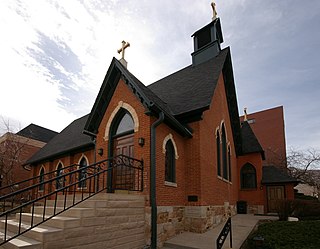
Calvary Episcopal Church is a Gothic Revival style chapel dating to the pioneer days of Golden, Colorado, United States. It is the oldest continuously used Episcopal church in Colorado, and is listed on the National Register of Historic Places.

The Loveland Block and the Coors Building are adjacent historic storefront buildings in downtown Golden, Colorado. The Loveland Block, named for pioneer William A.H. Loveland, once served as the territorial capitol building of Colorado. Both buildings are listed on the National Register of Historic Places as a single entity.
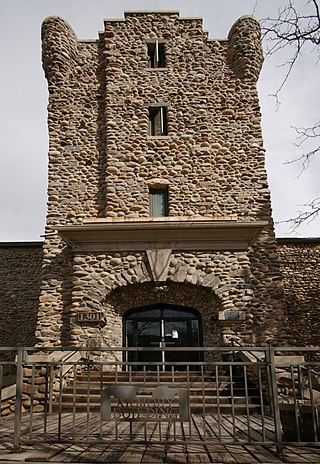
The Colorado National Guard Armory, known commonly by locals simply as the Armory, is a landmark in Golden, Colorado. Unusual in its construction, it was at one time the largest cobblestone building in the United States. It was built in 1913 by the Colorado National Guard as an armory, quarters, mess hall and auditorium for the Guard's Company A of Engineers. When it was completed in 1914, the Company was housed in this building's second and third floors while the first-story garden level was available for rental to the public. The Armory's original uses included: Golden's Post Office ; photo shop ; barracks, mess hall, weapons storage and drill hall ; auditorium ; and map room (tower). Its engineering company served with distinction and under fire in France in World War I and remained in service here. In subsequent years the building served in part or whole as a hotel, offices, industrial bank, and student housing. During the influenza epidemic of 1918 the building became an emergency hospital for ill patients used by the Red Cross, and in 1933 it became the local headquarters of the Civil Works Administration, the federal depression era agency which created several area improvements. Armory Hall was open to the public and served the community for social gatherings, fundraisers, sports, and was the early home of Golden's American Legion post. Calvary Episcopal Church is the current property owner.

Alumni Field, officially Alumni Field at Marv Kay Stadium, is an American college football stadium located in Golden, Colorado. The stadium serves as the home field of the Colorado Mines Orediggers football team representing the Colorado School of Mines. Alumni Field is one of the oldest football fields in existence, the oldest west of the Mississippi River and the oldest in NCAA Division II. Originally it was a dirt surface all-purpose athletic field in exactly its current configuration, built within a clay pit, a fitting mined-out home for the Orediggers. Its first athletic contest, held on May 20, 1893, was the first annual Colorado Inter-Collegiate Athletic Association Field Day, featuring many athletic contests between the University of Colorado, Colorado A&M, Colorado School of Mines, and the University of Denver, in which Mines claimed the most medals. Its first football game took place on October 7, 1893, a 6-0 Mines victory over the University of Denver. It has been home to the football Orediggers through all but the first five seasons of their existence, and has been renovated several times throughout its existence. The field was originally called Athletic Park, renamed Brooks Field after Mines trustee and benefactor Ralph D. Brooks in 1922. It was renamed Campbell Field after 1939 undefeated team member and benefactor Harry D. Campbell in 2010, and finally named Alumni Field in 2022. Alumni Field is the oldest football field in the west, the oldest in NCAA Division II football and the 5th oldest college football field in the nation.

Chichester Theological College (1838–1994) was an Anglican theological college for the Diocese of Chichester in Sussex, England. Its churchmanship was high church and Anglo-Catholic.

Fairmount Cemetery in Denver, Colorado, was founded in 1890 and is Denver's second oldest operating cemetery after Riverside Cemetery. It is located in land south-east of the intersection of the major Denver roadways Alameda Ave. and Quebec St.. The cemetery was designed by German landscape architect Reinhard Schuetze. The cemetery was patterned after Mount Auburn Cemetery in Cambridge and Watertown, Massachusetts. The cemetery occupies 280 acres (110 ha). The first year the cemetery opened over 4500 trees and shrubs were planted by Schuetze. The cemetery is the largest arboretum in the state.

The Mines Museum of Earth Science, formerly the Colorado School of Mines Geology Museum, is a geology museum located on the campus of the Colorado School of Mines, in Golden, Colorado, United States. It was established in 1877 by paleontologist and Mines' professor, Arthur Lakes. The first place to house the museum's collection was Jarvis Hall, which burnt down in 1878. While the museum awaited a new home, the collection continued to grow. Horace Patton was named Curator of the collection, still used primarily for teaching, in 1893. The collection was relocated to Guggenheim Hall in 1906, but upon Patton's retirement, the collection was relegated to storage. In 1940, upon completion of Berthoud Hall, home to Mines' geology department, the collection was unpacked by its newest Curator, J. Harlan Johnson and informally exhibited there until 2002.

The Trinity College Long Walk is a trio of conjoined buildings that form the core of Trinity College's campus in Hartford, Connecticut, United States. The three, Seabury Hall, Northam Tower, and Jarvis Hall, are the oldest buildings on the college's current campus.

George Maxwell Randall was the Episcopal bishop of Missionary District of Colorado and Parts Adjacent.

The Diocese of Colorado is the diocese of the Episcopal Church which covers all of Colorado. It is in Province VI. Its cathedral, Saint John's Cathedral, Denver, is located in Denver, along with its offices. John Franklin Spalding was the first bishop of the diocese. Kimberly "Kym" Lucas is the current bishop.

Caroline Bancroft was a journalist. She is known for the books and booklets that she wrote about Colorado's history and its pioneers. In 1990, she was inducted into the Colorado Women's Hall of Fame.

Frederick J. Bancroft was a surgeon during the American Civil War before he settled in Colorado, where he was considered to be "one of the most prominent physicians", according to a San Francisco Chronicle obituary. In the late 1870s, he and the Denver Medical Association created the public health system for Denver, Colorado to improve the health of its citizens. In 1876, Bancroft was the first president of Colorado's State Board of Health. He became Colorado Medical Society president in 1880. Bancroft was a founder and professor of the University of Denver and Colorado Seminary Medical Department in 1881.
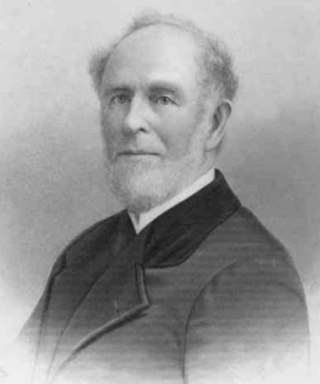
George Atwater Jarvis was an American businessman and philanthropist. Jarvis was successful in retail and wholesale grocery, banking, and insurance industries in New York. He was founder and vice president of South Brooklyn Savings Institution and president of the Lenox Fire Insurance Company. He sat on the board or was a trustee for many organizations.

















